The Albright Visitor Center at Mammoth Hot Springs is open daily year-round from 9 AM to 5 PM. Other visitor centers have seasonal hours: Canyon and Old Faithful Visitor Centers are open from April 21st to November 5th, while others like Fishing Bridge and Grant are open from May 26th to October 9th.
At Yellowstone National Park, the entrance fee is $35 for a private vehicle, $30 for motorcycles and snowmobiles, and $20 per person for a 7-day pass. An annual pass costs $70 for Yellowstone or $80 for an interagency pass valid at all national parks. Children under 16 enter free.
Getting to Yellowstone National Park depends on your starting point and preferred mode of transportation. By air: Fly into Bozeman Yellowstone International Airport (BZN), Jackson Hole Airport (JAC), or Yellowstone Regional Airport (COD) and rent a car. By car: Access via five entrance gates (North, West, South, East, Northeast) connected by highways US-89, US-191, and US-20. By bus or train: Tour buses from Jackson or Bozeman; Amtrak service to Salt Lake City or Whitefish with car rental. By RV: Drive and camp at park campgrounds with RV length restrictions.
Yellowstone has large parking lots like Old Faithful, with spaces for cars, RVs, and motorcycles. No overnight parking; entrance fees apply, but no parking fees. ADA and oversize vehicle spaces available. Check busy times to plan ahead.
Accessibility & permits
Emergency
- Cell service availability:Partial
Information not accurate?
Help us improve by making a suggestion.
Yellowstone National Park, spanning Wyoming, Montana, and Idaho, is a world-renowned destination offering an unparalleled mix of geothermal wonders, diverse wildlife, and breathtaking scenery. Established in 1872 as the world’s first national park, it captivates visitors with iconic landmarks like the Old Faithful geyser, the rainbow-hued Grand Prismatic Spring, and the powerful Yellowstone Falls. Beyond its famous sights, the park is a sanctuary for grizzly bears, bison, elk, and wolves, providing unforgettable wildlife encounters. With miles of hiking trails weaving through pristine forests and geyser basins, Yellowstone invites you to explore its vast wilderness and experience the raw beauty of America’s great outdoors.
- Area (mi²)
- 3472
- Annual visitors
- 4 500 000
- Established year
- 1872
Top 3 Facts about Yellowstone National Park
This region sits atop an active volcano, featuring one of the world’s largest calderas, measuring 45 x 30 miles, and experiences between 1,000–3,000 earthquakes annually.
Underlain by one of the world’s largest active volcanic systems, often called a supervolcano USGS
Provides critical habitat for diverse wildlife, including grizzly bears, wolves, bison, and elk
Family programs
- Junior Ranger
- Ranger-led Tours
- Workshops & Hands-on Activities
- Arts & Crafts
- Family Camping & Overnight
Travel Tips
Plan Ahead
Research park attractions, activities, and accommodations in advance; have a rough itinerary
Pack Appropriately
Yellowstone’s weather can be unpredictable: dress in layers, bring waterproof clothing, sunscreen, hats, and sunglasses
Respect Wildlife
Keep a safe distance from wildlife and never approach or feed animals; use binoculars for close-up views
Stay Informed
Arrive early or late to popular attractions to avoid crowds and enhance wildlife viewing opportunities
Seasons
Spring offers quieter crowds, emerging wildlife, and opportunities to witness newborn animals; be prepared for unpredictable weather and lingering snow
Summer is the peak tourist season, with warm temperatures, open roads, and full accessibility to park facilities and attractions; expect crowds and book accommodations well in advance
Fall brings cooler temperatures, vibrant foliage, and fewer crowds; wildlife viewing is excellent as animals prepare for winter
Winter offers a tranquil atmosphere with snow-covered landscapes; opportunities for cross-country skiing, snowshoeing, and wildlife viewing; select areas remain open with limited services
Information not accurate?
Help us improve by making a suggestion.
Frequently Asked Questions
Ready to dive into what Yellowstone National Park has to offer? Let’s tackle some of the burning questions you might have as you plan your visit!
-
Gardiner, Montana, offers the best access, lying just 0.7 miles from the North Entrance and providing year-round vehicle access through the Northeast Entrance. West Yellowstone, Montana, is also close, located just outside the West Entrance, only 0.9 miles away. Both towns provide quick entry to different parts of the park.
-
For young hikers, consider the Trout Lake Trail, a 1.2-mile round-trip hike to a beautiful mountain lake with opportunities to spot wildlife like otters and osprey. Another option is the Mystic Falls Trail, a 2.4-mile round-trip hike that starts at Biscuit Basin and features a 70-foot waterfall. The Natural Bridge Trail is also a good choice, a 1.5-mile partially paved trail leading to a unique rock formation.
-
No, you cannot take your dog on trails. Pets are not allowed on trails, boardwalks, or in the backcountry. They must stay within 100 feet of paved roads and parking areas.
-
Overnight RV parking is allowed only in designated campgrounds. Fishing Bridge RV Park is the only campground with full hookups and is restricted to hard-sided vehicles due to bear activity. Other campgrounds have length limits and require advance reservations.
-
Visit the Grand Canyon of the Yellowstone to see the Upper and Lower Falls and take in the pastel canyon walls. Explore Norris Geyser Basin for its unique blue and green pools. Stop by Mammoth Hot Springs to view its stunning geothermal formations. If time allows, check out the Grand Prismatic Spring and Old Faithful for their remarkable natural displays.








